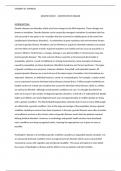STUDENT ID: 33498016
GENETICS ESSAY – HUNTINGTON’S DISEASE
INTRODUCTION:
Genetic diseases are disorders which arise from changes in the DNA sequence. These changes are
known as mutations. Genetic diseases can be caused by monogenic mutations (a mutation that has
only occurred in one gene) or by a mutation that has occurred in multiple genes at the same time
(multifactorial inheritance disorders) 1. A combination of gene mutations and environmental factors
can lead to genetic disease. Mutations can be inherited or acquired. Inherited mutations are passed
on from either one parent or both. Acquired mutations are random and can occur at any point in a
person’s lifetime. Furthermore, a change, damage or any abnormalities in chromosomes may also
lead to genetic diseases1. The most common illness caused by a chromosomal abnormality is
aneuploidy, which is a result of additional or missing chromosomes. Some examples of diseases
caused by aneuploidy are Down Syndrome, Klinefelter Syndrome and Turner Syndrome 2. The types
of genetic mutations are nonsense, missense, deletion, frameshift, and expanded repeats. All
acquired genetic illnesses are a result of one of the above types of mutation. Not all mutations are
expressed. However, an individual may be a carrier of a mutated gene. For example, a study carried
out on autosomal recessive inherited retinal diseases showed that 2.7 billion people worldwide are
healthy carriers of at least one mutation that causes the inherited retinal disease, whilst 5.5 million
are said to be affected3. Although certain genetic conditions are rare, it is thought that there has
been an increase in the number of diagnosed genetic disorders. In the UK, it is estimated that 30,000
babies and children are newly diagnosed each year and approximately 2.4 million people are living
with a genetic condition4. The World Health Organisation estimates that 10 out of every 1000 people
are affected by a genetic condition5. Due to the large percentage of the population having a genetic
condition, healthcare services have been impacted. In the past, genetic illnesses were often a burden
on healthcare services as the chronic nature of genetic illnesses meant that the patients required
lifelong medical attention6. However, as technology and genetic health services have developed,
more conditions are being recognised earlier, meaning the appropriate care is given as soon as
possible7.
Huntington’s disease is a hereditary genetic condition caused by an expanded repeats mutation. It is
an autosomal dominant condition8 and is a progressive brain disorder which causes uncontrolled
movements, issues with cognition and emotional instability 9. This essay will explore in more detail
the causes of Huntington’s disease and the effects it has on patients and their families.
, STUDENT ID: 33498016
CAUSE OF HUNTINGTON’S DISEASE:
Huntington’s disease is caused by an expanded repeats mutation. The mutation is a repeat of the
CAG codon, which is found in the HTT gene. The HTT gene is responsible for the coding of the
huntingtin protein and is found on chromosome four 10. The huntingtin protein is found in all
individuals and in many of the body’s tissues. However, it is predominantly found in the brain 11.
Although the exact function of the huntingtin protein is not known, it is thought to have a significant
role in brain development before birth. At a cellular level, the huntingtin protein is involved in
chemical signalling and the transportation of molecules 11.
A region of the HTT gene contains a DNA segment, which is known as the CAG trinucleotide repeat 9.
In a healthy individual, the number of CAG repeats is, on average, between 16 and 2012.
Huntington’s disease occurs when there is an expansion of over 35 repeats of the CAG repeat tract
within exon 1 of the HTT gene13. The additional repeats give rise to an elongated polyglutamine tract
at the amino terminus of the translated HTT protein. The mutated huntingtin protein is highly prone
to aggregation. The polyglutamine aggregates contain amyloid fibres with an abundance of β sheets.
The amyloid fibres also seclude many other proteins, including factors that are important for
transcription and protein quality control 13. This suggests that the aggregations are damaging to the
cellular function and have an input in the damage to the phenotype.
Furthermore, the length of the CAG tract is the primary determinant of the rate of the pathogenic
process that leads to the onset of the signs of Huntington’s. The length of the mutant expansion is
strongly correlated to the disease age of onset. 40 to 50 repeats lead to an adult onset, whilst 50 to
120 repeats lead to a juvenile form of the disease 14.
CLINICAL PRESENTATION OF HUNTINGTON’S DISEASE:
Huntington’s disease is a progressive brain disorder in which the cells in certain areas of the brain
are damaged15. It is most often diagnosed through neurological examinations (including diagnostic
imaging), medical histories and genetic testing 5,16.The clinical presentation may often vary depending
on the age of onset. Juvenile Huntington’s disease is a much rarer form of the disease which begins
in childhood or adolescence. However, both onsets of the disease present similar phenotypic
characteristics.
Changes in behaviour are often one of the first indications of Huntington’s disease. Other early
symptoms include a lack of emotion, apathy and periods of aggression or antisocial behaviour 17.




